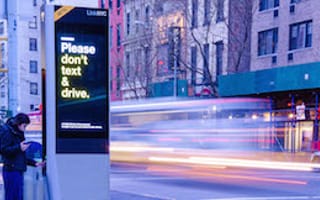
LinkNYC, a public-private partnership with the City of New York, is a first-of-its-kind initiative that provides fast, free wifi and digital services to millions of people in New York City — as well as a glimpse into the future.
The project, which is an amalgam of a communication network and next-gen adtech, was created out of New York’s existing payphones. Intersection, the urban innovation company behind LinkNYC, is replacing those payphones with at least 7,500 kiosks. Called Links, they provide free services, including gigabit wifi, phone calls, maps and wayfinding, as well as device charging to keep New Yorkers and visitors more connected and informed.
LinkNYC is free to use because it’s funded entirely through advertising. Each Link features two 55-inch digital displays, providing brands with a new location and context-aware platform to reach and engage with consumers.
We spoke with Dave Etherington, chief strategy officer at Intersection, to find out more about how the company wants to make cities smarter, particularly focusing on how brands interact with the physical spaces they occupy.
How did the idea for LinkNYC come to fruition?
I was involved at the very beginning with LinkNYC back when we were reimagining aging infrastructure and looking to solve all the challenges that New York and other cities around the world face. We were looking at opportunities and the idea that, if we could begin to overlay 21st century technology with 20th century infrastructure, then we could begin to improve the lives and experiences of everyone in the city. LinkNYC really is the first scalable example of that.
How did advertising play into that?
The last 10-15 years of innovation in advertising has all happened online. That innovation has changed the way we view content, how we make decisions and how we communicate. But there’s a real sense that the next decade of innovation is going to happen in physical spaces, and in cities in particular.
That’s why the role of brands in cities is key. The idea behind LinkNYC is that we have created these tools — whether it’s incredibly fast internet, phone calls or access to city services — and we’re giving it all away for free because we’re building it through advertisers.
What is the team behind LinkNYC like?
The team behind LinkNYC is made up of engineers, designers, project managers, media sales, marketers, construction teams and city planning/community group specialists. This is a truly massive undertaking and there are so many facets to each of these teams and the work they do on LinkNYC.
The team I am building, which is a team of strategic account directors, are really in the middle of all of this. These people are working and speaking with people in order to recontextualize the physical world or get people to think about the space for the first time. This team is really a team of creative thinkers and entrepreneurs who are trying to educate, inspire and find ways to be great strategic partners for advertising and media agencies. We want them to think about the tremendous opportunities that exist in cities with products like LinkNYC.
Now, we’re digitizing these opportunities, such as seeing the proliferation of digital displays. LinkNYC has more digital displays around the five boroughs than any other network. More than 1.4 million people have already signed up to use the wifi. Tens of thousands are using the tablet each week to access city services and make phone calls. This is only the beginning.
What are some examples of the types of advertising that have been successful through LinkNYC’s kiosks?
One of the first campaigns we did was with MillerCoors with the inspiration that nothing sums up the experience of being in a neighborhood more than plugging into the music people are listening to at that moment. We pulled a number of different brands — like Coors Light and Shazam — and we drew really tight geofences around the city and created these templates that are dated in real time. So in any location, and at any time, you could see the top 10 playlists people who had opted in were listening to. We saw an emotional response to this — people were trying to change their behaviors based on this aggregate campaign. It was a powerful moment that we hadn’t seen in physical places before.
Some of this content just helps people navigate their way around the city in a much more engaging and interesting way. What we’re seeing here is a new medium — one that has this enormous reach and footprint with all of the flexibility, engagement and strategic capabilities of online. In that way, I think we have the opportunity to dictate the future experience of cities hand in hand with big brands in the same way the internet changed our lives.
What are some of your long-term goals for this initiative?
Right now, we’re focused on rollout. And these kiosks have the power to make your commute easier, tell you about weather, help you discover what’s nearby you, etc. — it’s another way people can engage in the city experience and it’s another area for brands to place themselves in. We’re also excited to expand Link beyond New York — LinkUK is launching later this year.
How do you think LinkNYC contributes to the current shifts in media and technology at large?
The burgeoning trends in these spaces are computer vision, AI, mixed reality and autonomous vehicles, and the cool thing about all of these is that they happen in the physical world. Link can become a part of that experience or it can provide a conduit through which those things can become more meaningful at large.
Photo via Intersection.
Know of a company that deserves coverage? Let us know or tweet us @builtinnewyork.




